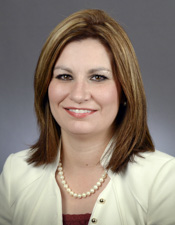Home visits could help more pregnant teens and their children
With the help of a public health nurse, Sha’Quaria Adkins was able to earn her GED and secure a job as a pharmacy technician after becoming pregnant as a young high schooler. Next month, she’s scheduled to start classes to become a certified nursing assistant, she told the House Health and Human Services Finance Committee Tuesday.
“Anything else I want to do, I have help all around,” she said after testifying about the Hennepin County home visiting program. “I’m just trying to do something in life. I want to make my family proud, I want to make my children proud. I want to make myself proud. I want to be a better me.”
Sponsored by Rep. Mary Franson (R-Alexandria), HF1564 would appropriate $31 million in the 2018-19 biennium and $51 million in the 2020-21 biennium to provide home visiting services to more pregnant and parenting teens. It was held over, as amended, for possible inclusion in a potential omnibus bill.
It has no Senate companion, but the proposed appropriations line up with the amounts recommended in Gov. Mark Dayton’s budget for the program.
The additional funding is expected to provide services to more than 3,600 pregnant and parenting teens each year, Franson said.
Teen parents are less likely to graduate high school than their peers and more likely to live in poverty. Meanwhile, their babies are more often born prematurely and at risk for low birthweights, and developmental delays.
But home visits conducted by public health nurses can lead to improved prenatal health, development and school readiness as well as less childhood injuries and fewer cases of abuse or neglect, advocates say.
While there is some sort of home visiting program in every Minnesota county, long-term programs for teen parents need to expand in Greater Minnesota, where nearly 51 percent of teen births occur, said Karen Adamson, a member of the executive committee for the Minnesota Coalition for Targeted Home Visiting and Hennepin County program manager.
In Ramsey County, home visitation programs for new mothers date back nearly 100 years. There, public health nurses use a targeted strategy to provide support and education to teen parents, said Joan Brandt, a co-chair of the coalition and Family Health Division manager at St. Paul-Ramsey County Public Health.
“Adolescence is hard enough without having a kid,” Brandt said in an interview Monday. “To have that home nurse involved in the teen’s life at this critical stage in her development can make all the difference.”
Teen parents often have little parenting knowledge and weak support structures. Many have unstable housing situations or are homeless, she said.
Home health nurses begin visiting with teen mothers from the time they’re identified for participation in a program through their child’s second or third birthday. Visits can vary from once a week to once every few months depending on the mother and child, Brandt said.
Pre-natal visits can range from connecting the mother with a pre-natal health care provider and discussing what to expect during labor and delivery, to teaching her about postpartum depression and how to hold a baby.
“My nurse helped me to be as prepared as I could for the birth of my son. Knowing how to take care of him … this gave me more confidence in being a mom,” said Ana Delgado, a high school junior from Little Canada who started meeting with a nurse when she was three months pregnant.
After the baby is born, home health nurses continue meeting with the mothers to help with breast feeding, teach mothers how to interact with their baby, and watch for developmental milestones. They also conduct screenings for depression and continue connecting the mother with whatever services she and her child need.
For Delgado, that included day care – which allowed her to continue attending school – and a driver’s education program, while Adkins’s nurse helped her access therapy, shelter services, and a GED program.
Adkins said that since her mother never graduated high school, she initially dismissed demands that she do anything different. But through her work with a home health nurse and a mentor, she developed the motivation she needed to press through the challenges and thrive.
“If I want them to achieve something in life, I need to be an example for them,” she told the committee.
Getting teen mothers through high school and helping them develop post-graduation plans is one of the keys to improving their futures, and that of their children, advocates say.
“It is one of the strongest predictors to get out of poverty. If a teen can get out of high school, they are better equipped to enter the job market or go on to higher education,” Brandt said
Delgado plans on graduating next year and wants to pursue some sort of secondary education.
“I want my son to know that education is important … (and) prove everybody wrong who said my life was over because I was a teen parent,” she said.
Related Articles
Search Session Daily
Advanced Search OptionsPriority Dailies
Ways and Means Committee OKs proposed $512 million supplemental budget on party-line vote
By Mike Cook Meeting more needs or fiscal irresponsibility is one way to sum up the differences among the two parties on a supplemental spending package a year after a $72 billion state budg...
Meeting more needs or fiscal irresponsibility is one way to sum up the differences among the two parties on a supplemental spending package a year after a $72 billion state budg...
Minnesota’s projected budget surplus balloons to $3.7 billion, but fiscal pressure still looms
By Rob Hubbard Just as Minnesota has experienced a warmer winter than usual, so has the state’s budget outlook warmed over the past few months.
On Thursday, Minnesota Management and Budget...
Just as Minnesota has experienced a warmer winter than usual, so has the state’s budget outlook warmed over the past few months.
On Thursday, Minnesota Management and Budget...
